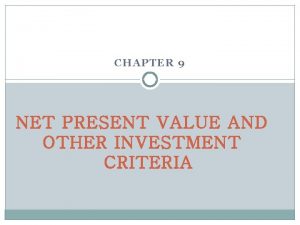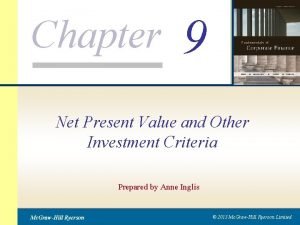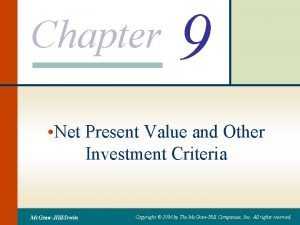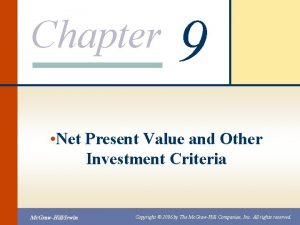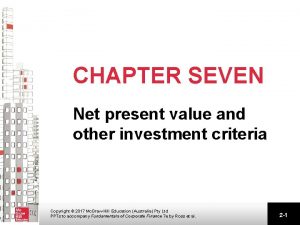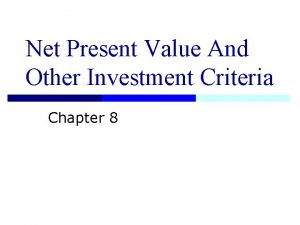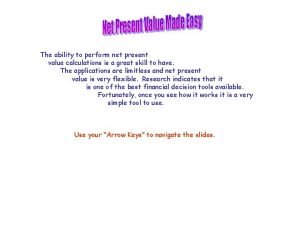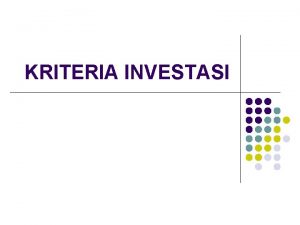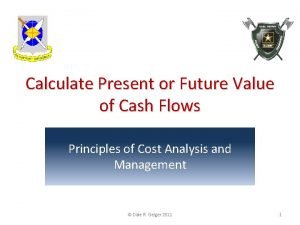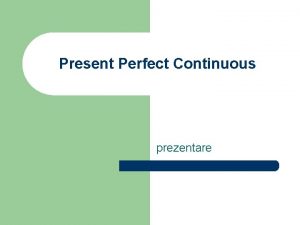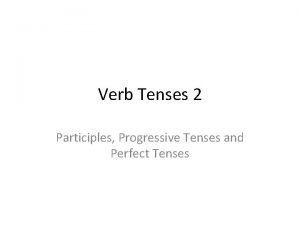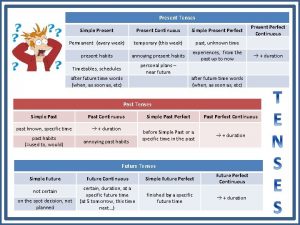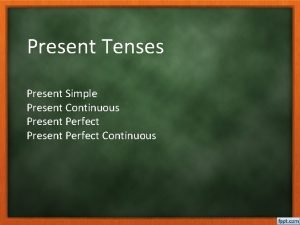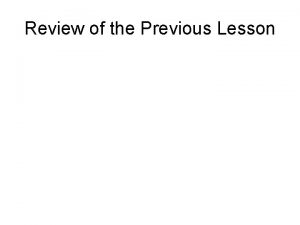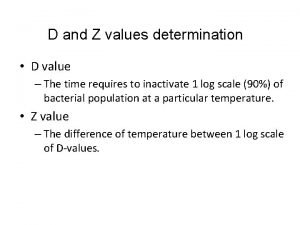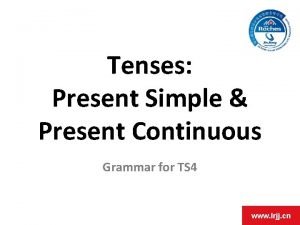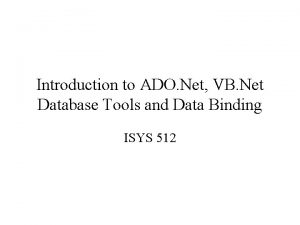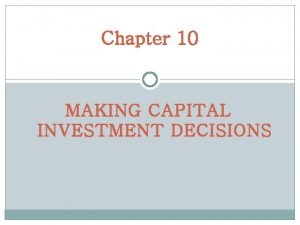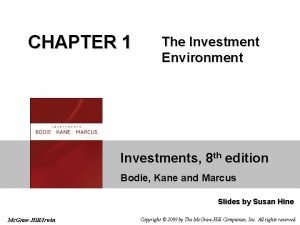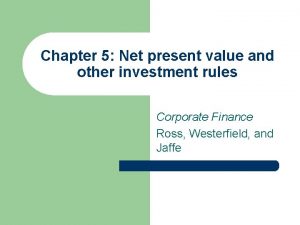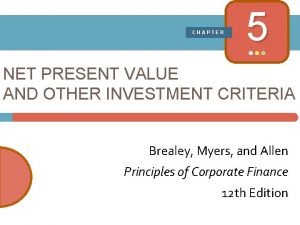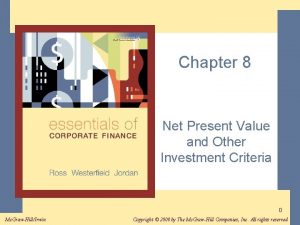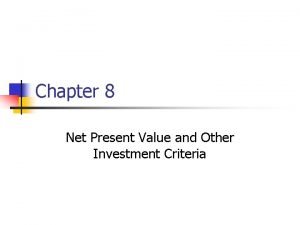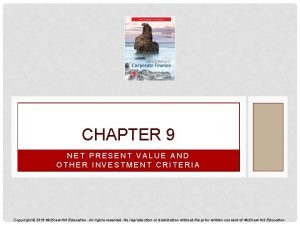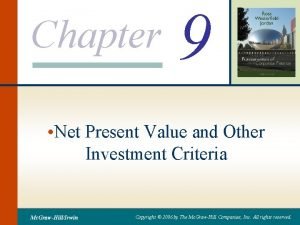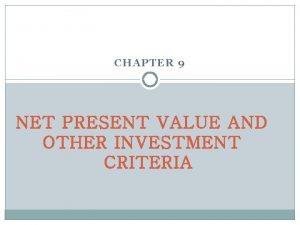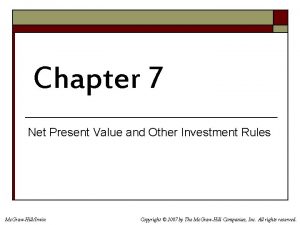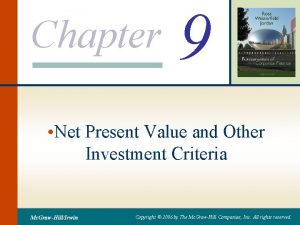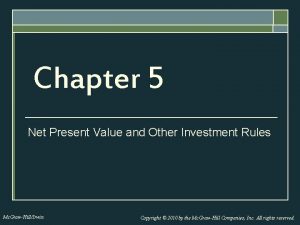Chapter 7 Net Present Value and Other Investment







































- Slides: 39

Chapter 7 Net Present Value and Other Investment Rules

Key Concepts and Skills Be able to compute payback and discounted payback and understand their shortcomings � Understand accounting rates of return and their shortcomings � Be able to compute the internal rate of return and profitability index, understanding the strengths and weaknesses of both approaches � Be able to compute the net present value and understand why it is the best decision criterion �

Capital Budgeting Deciding what investments the company should make � Four Criteria that a good procedure for evaluating proposed investments should meet. ◦ (1) Base the analysis on incremental costs and benefits, and don’t arbitrarily exclude any costs or benefits from the analysis. ◦ (2) Measure costs and benefits based on cash flows, not earnings. ◦ (3) Allow for time value of money and for the risk involved. ◦ (4) If forced to choose among proposals, select the one that does shareholders the most good.

The Net Present Value (NPV) Rule Net Present Value (NPV) = Total PV of future CF’s + Initial Investment � Estimating NPV: � 1. Estimate future cash flows: how much? and when? 2. Estimate discount rate 3. Estimate initial costs Minimum Acceptance Criteria: Accept if NPV >0 � Ranking Criteria: Choose the highest NPV �

Net Present Value: Example � Suppose Big Deal Co. has an opportunity to make an investment of $100, 000 that will return $33, 000 in year 1, $38, 000 in year 2, $43, 000 in year 3, $48, 000 in year 4, and $53, 000 in year 5. If the company’s required return is 12% should they make the investment? Answer: YES! The NPV is greater than $0. Therefore, the investment does return at least the required rate of return.

Why Use Net Present Value? � Accepting positive NPV projects benefits shareholders. ü NPV uses cash flows ü NPV uses all the cash flows of the project ü NPV discounts the cash flows properly � Reinvestment assumption: the NPV rule assumes that all cash flows can be reinvested at the discount rate.

Calculating NPV with Spreadsheets � � Spreadsheets are an excellent way to compute NPVs, especially when you have to compute the cash flows as well. Using the NPV function: ◦ The first component is the required return entered as a decimal. ◦ The second component is the range of cash flows beginning with year 1. ◦ Add the initial investment after computing the NPV.

The Payback Period Method � � � How long does it take the project to “pay back” its initial investment? Payback Period = number of years to recover initial costs Minimum Acceptance Criteria: ◦ Set by management; a predetermined time period � Ranking Criteria: ◦ Set by management; often the shortest payback period is preferred

Example: Payback Method � Consider a project with an investment of $50, 000 and cash inflows in years 1, 2, & 3 of $30, 000, $20, 000, $10, 000 � The timeline above clearly illustrates that payback in this situation is 2 years. The first two years of return = $50, 000 which exactly “ pays back” the initial investment

The Payback Period Method � Disadvantages: ◦ ◦ ◦ � Ignores the time value of money Ignores cash flows after the payback period Biased against long-term projects Requires an arbitrary acceptance criteria A project accepted based on the payback criteria may not have a positive NPV Advantages: ◦ Easy to understand ◦ Biased toward liquidity

The Discounted Payback Period � � � How long does it take the project to “pay back” its initial investment, taking the time value of money into account? Decision rule: Accept the project if it pays back on a discounted basis within the specified time. By the time you have discounted the cash flows, you might as well calculate the NPV.

Example: Discounted Payback Period � Suppose Big Deal Co. has an opportunity to make an investment of $100, 000 that will return $33, 000 in year 1, $38, 000 in year 2, $43, 000 in year 3, $48, 000 in year 4, and $53, 000 in year 5. If the company’s required return is 12% and predetermined payback period is 3 years should they make the investment? Answer: NO! At the end of three years the project has still not broken even or “ paid back”. Therefore, it must be rejected.

Average Accounting Return � � Another attractive, but fatally flawed, approach Ranking Criteria and Minimum Acceptance Criteria set by management

Example: Average Accounting Return

Average Accounting Return � Disadvantages: ◦ Ignores the time value of money ◦ Uses an arbitrary benchmark cutoff rate ◦ Based on book values, not cash flows and market values � Advantages: ◦ The accounting information is usually available ◦ Easy to calculate

The Internal Rate of Return � � IRR: the discount rate that sets NPV to zero Minimum Acceptance Criteria: � Ranking Criteria: � Reinvestment assumption: ◦ Accept if the IRR exceeds the required return ◦ Select alternative with the highest IRR ◦ All future cash flows assumed reinvested at the IRR

Internal Rate of Return (IRR) � Disadvantages: ◦ Does not distinguish between investing and borrowing ◦ IRR may not exist, or there may be multiple IRRs ◦ Problems with mutually exclusive investments � Advantages: ◦ Easy to understand communicate

IRR: Example Consider the following project: 0 -$200 $50 $100 $150 1 2 3 The internal rate of return for this project is 19. 44%

NPV Payoff Profile If we graph NPV versus the discount rate, we can see the IRR as the x-axis intercept. IRR = 19. 44%

Calculating IRR with Spreadsheets � � You start with the cash flows the same as you did for the NPV. You use the IRR function: ◦ You first enter your range of cash flows, beginning with the initial cash flow. ◦ You can enter a guess, but it is not necessary. ◦ The default format is a whole percent – you will normally want to increase the decimal places to at least two.

Problems with IRR q Multiple IRRs q Are We Borrowing or Lending q The Scale Problem q The Timing Problem

Multiple IRRs There are two IRRs for this project: $200 0 -$200 1 $800 2 3 - $800 Which one should we use? 100% = IRR 2 0% = IRR 1

Modified IRR � Calculate the net present value of all cash outflows using the borrowing rate. � Calculate the net future value of all cash inflows using the investing rate. � Find the rate of return that equates these values. � Benefits: single answer and specific rates

The Scale Problem Would you rather make 100% or 50% on your investments? What if the 100% return is on a $1 investment, while the 50% return is on a $1, 000 investment?

The Timing Problem $10, 000 $1, 000 Project A 0 1 2 3 -$10, 000 $1, 000 $12, 000 Project B 0 -$10, 000 1 2 3

The Timing Problem 10. 55% = crossover rate 12. 94% = IRRB 16. 04% = IRRA

Calculating the Crossover Rate Compute the IRR for either project “A-B” or “B-A” 10. 55% = IRR

NPV versus IRR � � NPV and IRR will generally give the same decision. Exceptions: ◦ Non-conventional cash flows – cash flow signs change more than once ◦ Mutually exclusive projects �Initial investments are substantially different �Timing of cash flows is substantially different

NPV versus IRR � Mutually Exclusive -- only ONE of several potential projects can be chosen, e. g. , acquiring an accounting system. ◦ RANK all alternatives, and select the best one. � Independent Projects: accepting or rejecting one project does not affect the decision of the other projects. ◦ Must exceed a MINIMUM acceptance criteria

The Profitability Index (PI) � Minimum Acceptance Criteria: ◦ Accept if PI > 1 � Ranking Criteria: ◦ Select alternative with highest PI

The Profitability Index � Disadvantages: ◦ Problems with mutually exclusive investments � Advantages: ◦ May be useful when available investment funds are limited ◦ Easy to understand communicate ◦ Correct decision when evaluating independent projects

The Practice of Capital Budgeting � � � Varies by industry: ◦ Some firms use payback, others use accounting rate of return. The most frequently used techniques for large corporations are IRR and NPV. Payback more often used by small firms and firms with CEOs without an MBA

Example of Investment Rules Compute the IRR, NPV, PI, and payback period for the following two projects. Assume the required return is 10%. Year Project A Project B 0 -$200 -$150 1 $200 $50 2 $800 $100 3 -$800 $150

Example of Investment Rules CF 0 PV 0 of CF 1 -3 NPV = IRR = PI = Project A -$200. 00 $241. 92 $41. 92 0%, 100% 1. 2096 Project B -$150. 00 $240. 80 $90. 80 36. 19% 1. 6053

Example of Investment Rules Payback Period: Time 0 1 2 3 Project A Project B CF Cum. -200 -150 2000 50 800800 100 -8000 150 CF CF -150 -100 0 150 Cum. CF Payback period for project B = 2 years. Payback period for project A = 1 or 3 years?

NPV and IRR Relationship Discount rate -10% 0% 20% 40% 60% 80% 100% 120% NPV for A -87. 52 0. 00 59. 26 59. 48 42. 19 20. 85 0. 00 -18. 93 NPV for B 234. 77 150. 00 47. 92 -8. 60 -43. 07 -65. 64 -81. 25 -92. 52

NPV Profiles $400 $300 IRR 1(A) IRR (B) IRR 2(A) $200 $100 $0 -15% 0% 15% 30% 45% 70% 100% 130% 160% 190% ($100) ($200) Cross-over Rate Discount rates Project A Project B

Summary – Discounted Cash Flow � � � Net present value ◦ Difference between market value and cost ◦ Accept the project if the NPV is positive ◦ Has no serious problems ◦ Preferred decision criterion Internal rate of return ◦ Discount rate that makes NPV = 0 ◦ Take the project if the IRR is greater than the required return ◦ Same decision as NPV with conventional cash flows ◦ IRR is unreliable with non-conventional cash flows or mutually exclusive projects Profitability Index ◦ Benefit-cost ratio ◦ Take investment if PI > 1 ◦ Cannot be used to rank mutually exclusive projects ◦ May be used to rank projects in the presence of capital rationing

Summary – Payback and Accounting Criteria � � � Payback period ◦ Length of time until initial investment is recovered ◦ Take the project if it pays back in some specified period ◦ Doesn’t account for time value of money, and there is an arbitrary cutoff period Discounted payback period ◦ Length of time until initial investment is recovered on a discounted basis ◦ Take the project if it pays back in some specified period ◦ There is an arbitrary cutoff period Average Accounting Return ◦ Measure of accounting profit relative to book value ◦ Similar to return on assets measure ◦ Take the investment if the AAR exceeds some specified return level ◦ Serious problems and should not be used
 Advantage and disadvantage of npv
Advantage and disadvantage of npv Net present value and other investment criteria
Net present value and other investment criteria Chapter 9 net present value and other investment criteria
Chapter 9 net present value and other investment criteria Chapter 9 net present value and other investment criteria
Chapter 9 net present value and other investment criteria Net present value of investment
Net present value of investment Fixed investment and inventory investment
Fixed investment and inventory investment Penciptaan nilai adalah
Penciptaan nilai adalah Bcr formula
Bcr formula Mutually exclusive projects
Mutually exclusive projects Payback chapter 8
Payback chapter 8 Net present value practice problems
Net present value practice problems Net present value assumptions
Net present value assumptions Net present value
Net present value Npv adalah
Npv adalah Present value vs future value
Present value vs future value Present simple present continuous and present perfect
Present simple present continuous and present perfect Value line investment survey
Value line investment survey Self-initiated other-repair examples
Self-initiated other-repair examples I write a letter now past continuous tense
I write a letter now past continuous tense Present perfect simple and present continuous
Present perfect simple and present continuous Present perfect present simple present continuous
Present perfect present simple present continuous Which verb tenses describe continuing action?
Which verb tenses describe continuing action? Present continuous in reported speech
Present continuous in reported speech Present simple present continuous present perfect
Present simple present continuous present perfect Firm based trade theory
Firm based trade theory Mankiw chapter 26 solutions
Mankiw chapter 26 solutions Value received and value parted with
Value received and value parted with Calculate fold change
Calculate fold change D value and z value
D value and z value Acid value principle
Acid value principle Creating and capturing value
Creating and capturing value Be forms
Be forms Achmed lach net
Achmed lach net Ado.net vb.net
Ado.net vb.net The investment environment chapter 1 ppt
The investment environment chapter 1 ppt Intermediate accounting chapter 17
Intermediate accounting chapter 17 Cca formula
Cca formula Afnan hossain
Afnan hossain Nwc change
Nwc change Chapter 1 the investment environment
Chapter 1 the investment environment
